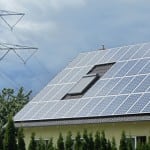Germany’s levy to promote renewables under the 2008 Renewable Energy Act (EEG) will climb to €0.0624/kWh in 2014—a 20% increase that represents nearly a fifth of residential electricity bills. The measure announced by the country’s four transmission system operators (TSOs), who independently determine the EEG surcharge, is already under considerable political debate.
As RWE’s Sebastian Ackermann explains it, because power produced by wind turbines and photovoltaics is “much more expensive” than power from conventional power stations, “operators of these facilities receive a subsidy for the energy they feed into the grid, which is significantly higher than market prices on the energy exchange.” Rules for these subsidies are outlined in the EEG Act, but that law also outlines how much of the additional cost incurred in generating renewable energy is passed on to consumers. The EEG levy is included in the electricity prices that power companies charge their customers. “These companies act as collection agencies and pass on the money to the grid operators,” explains Ackermann. “The grid operators then use this money in its entirety to pay for the energy from the [renewable power] producers.”
The latest increase in the EEG levy compares to €0.0131/kWh in 2009 and €0.0528/kWh in 2013. Next year, it will amount to about €23.6 billion ($32 billion). Many argue that it has successfully spurred the increase of renewables in Germany (Figure 1), which is in the process of phasing out nuclear power and has ambitions to produce 80% of its power from renewables in 2050 compared to the current 23%. In 2011 alone, for example, the number of renewable facilities connected to the grid soared by 24%, while renewable energy increased 16%. In October, the country’s TSOs said forecasts showed another significant increase of renewable generation in the upcoming year, increasing from the current 135 TWh to 150 TWh.
But the levy also means the average German household currently pays €180 ($242) per year to subsidize renewable energy. Meanwhile, no upper limit on Germany’s subsidies for renewables has been set. Another sticking point is that the EEG levy is nearly 25% higher for residential and business consumers than for industrial users, though as Ackermann points out, “The key reason for [these exceptions] is the fear that energy-intensive companies in Germany will move away, and take jobs with them.”
However, Germany’s BDI industry federation, which represents about 100,000 companies, including Siemens AG, said in a statement in October that re-elected Chancellor Angela Merkel’s third-term government must “radically reform” the EEG to tamp down industry costs, which are straining energy-intensive sectors like steelmakers. A recent BDI study predicts electricity prices for big industrial customers in Germany may grow on the back of the EEG levy and increasing grid costs from €90/MWh in 2012 to around €98/MWh to €110/MWh in 2020. That compares to a projected increase of just €48/MWh to €54/MWh over the same period in the U.S., when cheap shale gas is factored in.
The government has said it will amend the EEG law once Merkel’s Christian Democratic bloc reaches an agreement with another party to form a new coalition following the September elections. Members of Germany’s Green Party, which championed the nuclear phaseout and have rallied for renewables, say adding new wind turbines and solar panels only account for 10% of the EEG levy’s increase. They instead point to a failing power market and industry aid that has been misappropriated by the government on non-privileged electricity customers.
—Sonal Patel, associate editor (@POWERmagazine, @sonalcpatel)
CORRECTION (January 2014): Germany’s EEG levy was lifted to 6.24 (euro) cents/kWh for 2014, up from 5.28 cents/kWh in 2013 (and 3.27 cents/kWh in 2012)—not €0.624/kWh in 2014, up from €0.528/kWh in 2013 as had been erroneously claimed in a previous version of this article. The corrected version also now notes that a BDI study predicts that electricity prices for Germany’s big industrial customers could increase grid costs from €90/MWh (not kWh) in 2012 to around €98/MWh to €110/MWh in 2020. POWER regrets the errors.










